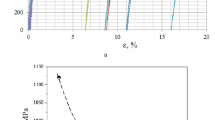Abstract
We study the dislocation structure of a Tindash;5percnt;Alndash;5percnt;V alloy upon cyclic-strength and crack-propagation resistance tests with symmetrical tensionndash;compression loading with frequencies of 100 Hz, 500 Hz, 3 kHz, and 10 kHz. The identity of the test conditions has allowed us to carry out a comparative analysis of the influence of the loading frequency on the evolution of the dislocation structure in the material main volume during the fatigue-damage accumulation and in the fracture zone during the fatigue-crack propagation. It is shown that at these two loading stages the plastic-deformation micromechanisms adapt themselves to the loading rate. In the first case, this is due to the fact that a decrease in the activity of the work of the Frankndash;Read sources in high-frequency loading is compensated for by a more pronounced deformation of the alpha;-phase as a result of the formation of stacking faults. In the second case, the high level of local stresses activates the cross sliding and the formation of a honeycomb structure in the alpha;- and beta;-phases, and the elements of this structure decrease in size with increasing loading frequency. The incompleteness of relaxation processes in high-frequency cyclic loading is offset by the deformation of boundary volumes which are initially present in the alpha;-phase of twins.
Similar content being viewed by others
References
L. E. Matokhnyuk, Accelerated Fatigue Tests with High-Frequency Loading [in Russian], Naukova Dumka, Kiev (1988).
K. J. Miller and R. Akid, “The application of microstructural fracture mechanics to various metal surface states,” Proc. Roy. Soc. London. A, 452, No. 1949, 1411- 1432 (1996).
K. J. Miller, “A historical perspective of the important parameters of metal fatigue and problems for the next century,” in: Fatigue'99 (Proc. 7th Int. Congress, Beijing, China, 8- 12 June, 1999.), Vol. 1, High Education Press, Beijing (1999), pp. 15- 39.
Titanium Alloys. Metallography of Titanium Alloys [in Russian], Metallurgiya, Moscow (1980).
L. E. Matokhnyuk, G. N. Nadezhdin, and T. Yu. Yakovleva, “A study of fatigue fracture of titanium alloys over a wide range of loading frequencies,” in: Mechanical Fatigue of Metals (Proc. VIth Inter. Colloq.) [in Russian], Naukova Dumka, Kiev (1980).
B. A. Kolachev, Physical Metallurgy of Titanium [in Russian], Metallurgiya, Moscow (1976).
V. M. Kosevich and L. S. Palatnik (Eds.), Electron-Microscopic Images of Dislocations and Stacking Faults. A Handbook [in Russian], Nauka, Moscow (1976).
H. C. Gu, “Cyclic deformation and substructure evolution in titanium and zirconium,” in: Fatigue'99 (Proc. 7th Int. Congress, Beijing, China, 8- 12 June, 1999), Vol. 1, High Education Press, Beijing (1999), pp. 131- 138.
A. Suhua, W. Rhongguang, and X. Yuebo, “The fatigue deformation and fracture characteristics of coarse grained polycrystalline α-titanium,” Scr. Met., 19, No. 9, 1099- 1103 (1985).
J. Friedel, Dislocations, Pergamon Press, Oxford- London- Edinburg- New York- Paris- Frankfurt (1964).
M. L. Bernshtein and V. A. Zaimovskii, Structure and Mechanical Properties of Metals [in Russian], Metallurgiya, Moscow (1970).
N. Tanaka and H. Conrad, “Dislocation velocity in alpha-titanium,” Acta Met., 19, No. 10, 1001- 1008 (1971).
M. A. Krishtal and S. A. Golovin, Internal Friction and Structure of Metals [in Russian], Metallurgiya, Moscow (1976).
I. I. Novikov (Ed.), Advances in the Physics of Metals [in Russian], Metallurgizdat, Moscow (1956).
Science, Technology and Application of Titanium, Pergamon Press, Oxford- London (1970).
Author information
Authors and Affiliations
Rights and permissions
About this article
Cite this article
Yakovleva, T.Y. Dislocation Structure of VT22 Titanium Alloy in Cyclic Loading with Various Loading Frequencies. Strength of Materials 32, 331–338 (2000). https://doi.org/10.1023/A:1026600617137
Issue Date:
DOI: https://doi.org/10.1023/A:1026600617137



